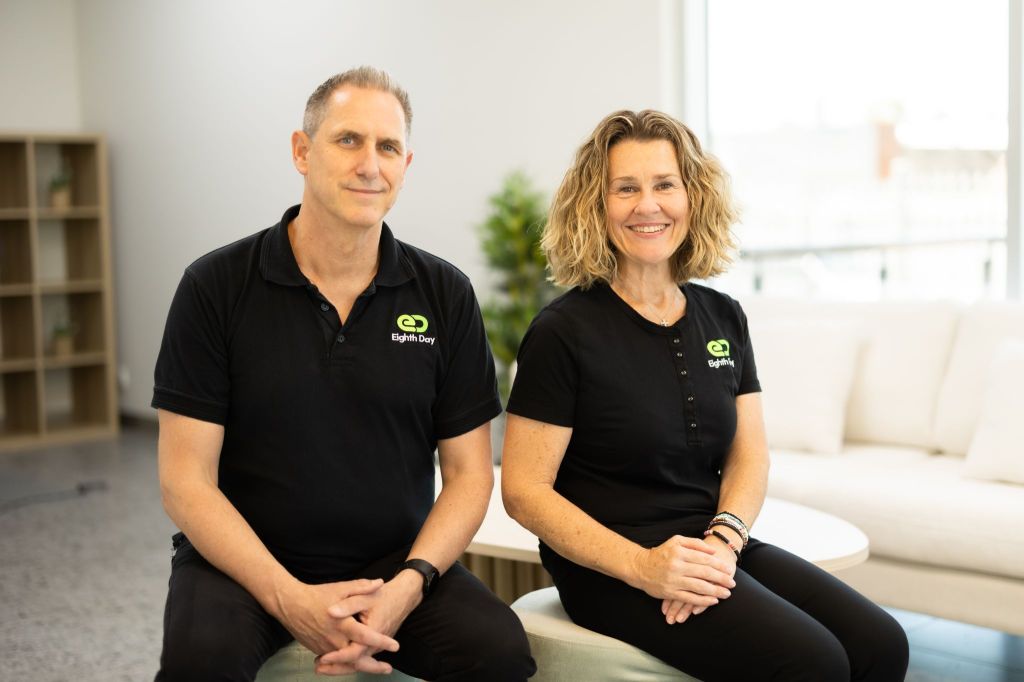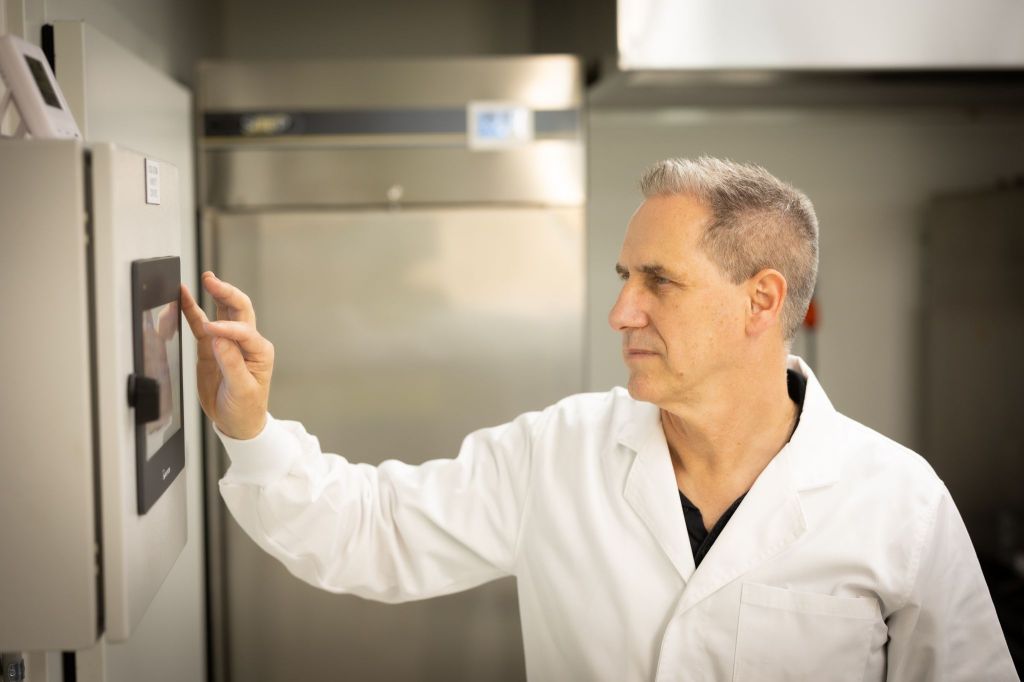Australian alternative protein company Eighth Day Foods recently announced it was looking for a buyer for its proprietary Rapid Solid State Fermentation technology.
The company claims that its process bypasses many of the challenges associated with alt protein products such as overprocessing by using the entire seed and a fermentation process to create a whole-cut product that functions the same as meat.
Following on our interview from last year, Future Alternative caught up with co-founder Roger Drew to discuss the background behind the company’s shift towards selling their technology. Drew also shared his vision of what the next phase of the alternative protein industry is going to look like.

You recently announced that you’re looking for a buyer for your proprietary Rapid Solid-State Fermentation technology, a move not seen often in the industry. In your view, where is alternative protein at right now?
If you go back two or three years, [alternative protein] was really the sweetheart of the food industry. Everyone was on board and really excited about the prospects of bringing significant change, in the sense that, we’ve got a looming existential problem with animal protein, so how do we bring a better path? The industry could almost do no wrong in 2019 and 2020.
But as you know, our industry has faced more and more headwinds along the way, some of those having come from external parties, such as lobby groups within the meat and dairy industries, and some from governments. But I think most of it has actually been self-inflicted. And that’s the part that makes me sad from the inside of the industry, that those who had raised a lot of funds and had the resources to do something really significant haven’t been able to fulfill those promises.
On price, we haven’t been able to get it down to where people are sufficiently incentivised on price. The other factor has been the product itself. Have we really come up to what people wanted? If we’d offered great alternatives to animal protein, that’s one thing. But because we said, ‘You won’t be able to tell the difference between this and meat’, that set a really high standard that has been almost impossible to meet.
In terms of health, are we making something healthier or not? And that’s a challenge. But I think most of that has come from us in the industry almost believing our own hype. It’s gone from facing headwinds to facing a cliff at the moment.
It really all comes around unit economics, and the fact that no one’s making money. If the biggest brands, with the biggest scale, cannot turn a profit on their product, we have to ask if there is something fundimentally wrong with the processes being used and the products being made.
Eventually, the cash runs out, and unfortunately I think we are going to see that happen for some very large players throughout 2024, globally, and throughout every part of the industry where the unit economics don’t work.
Can you provide some examples of where you see this happening?
One is what I call the isolated protein synthetic blends, your plant based blends that have 15, 20, or 25 ingredients. Just consider the cost of pulling that together. We’ve got some big players who have had really deep pockets, both here in Australia and in the US, and they just cannot get the economics to work.
Then you have the biomass microprotein blends – again, big players with enormous infrastructure required.
And cultivated meat, we’re probably five to ten years away from really having any chance of doing that. And there’s so many unresolved questions about the technology at scale.
So price for me is the biggest cliff that we’ve got to go over at the moment. And I think the industry is actually struggling to find a path that’s straightforward to get around that, because tweaking won’t make a difference. It has to be a fundamental, massive shift.
What then do you think is the next logical play for companies in the industry?
If we go back through history and we look at all the proteins that have come into existence that have grown throughout the world, you’ve got fish, sheep, cattle and so forth. And they’re foods that grow naturally. We’ve modified it and changed it a bit, but they’re things that walk around naturally.
Then later on you’ve got tofu, you’ve got chicken that became really popular, and then even tempeh and the like. And all of those were products that you could make in your village, but it took hundreds of years for those to develop and expand globally.
But not one of these were a copy of something else. They all naturally emerged from what we grow and the animals we have grazing. And I think the next phase for us won’t be a quick one because it’ll emerge in the same way. It needs to be something that grows naturally. For us to put a whole lot of ingredients together to mimic something else is always going to be an uphill battle. So, I believe we’ll end up going back to the source of our food.
There’s a really health philosophy that my co-founder Jen adheres to – that we need to honor the produce of the land. And then that produce will come through and it’ll be enjoyable and healthy for us. And, significantly, the economics will work.
There’s a excellent paper in the UK that just came out in the last week on price parity in plant based proteins. It states that, when a protein is isolated from its source, we remove the fats and some carbohydrates and fiber and functionality. When only the expensive isolated protein remains, we’ve got to add back some fat and some carbohydrate and some fiber to recreate a product – even when those things are intrinsically in the plants to begin with. Maybe we can let Occam’s razor guide us here, and let the simple path from source to plate provide the obvious solution.
Is it that thinking that has taken to your current business model shift?
Some of our investors asked the question: why the radical turn in this direction – to sell now? A group of us went back and had a look at an image of the whiteboard when we did our first brainstorming. Back in early 2021, when we had some external people come and help, we said this is a research and development, innovation-based company.
When we dug down into the economics of our process, on who would be making the most money along the supply chain, the unit economics on manufacturing were off the scale – the margins are really quite significant in an industry that struggles to find profitability at all. Because of the innovation and technology that we have, the cost to produce it is so small. So, manufacturing was our obvious focus back then.
How the investment landscape has changed since then. Billions spent, though little achieved on scaling affordable products. The market has stalled. CAPEX estimates are breathtaking. Without a clear path forward, it is little wonder that investors find it difficult to “put good money after bad.” All that said, the need for new proteins has not gone away. We still require a solution – and this is where each of us need to stick to our lanes.
Start-ups are really good at innovation, but it’s really hard for big food to have that free thinking, to be able to explore outside, because they’ve all got their tasks that they need to do. Whereas, manufacturing is best done by big food who have deep pockets – they know how to manufacture food and they’ve got really good reach into the market.
It is very rare that you’ll find a company that can do the tech side of things really well plus build the business out on the other side. It might work for internet start-ups, because it’s easy to scale, but in food it is completely the opposite. That whole scaling side of things needs deep pockets and deep experience. That’s what turned Eighth Day Foods back around, and we’re not alone.
It’s almost the universal voice in the industry at the moment. With consolidation happening between companies, companies are saying ‘we need to get co-manufacturers in, we need to do this in a smarter way’. And for us, we know that our core innovation hurdle has been crossed – and this technology is most valuable to those who can scale it quickly.
We’re very much a purpose-driven company and we want to make a difference in the world. The technology can only make a difference if it’s scaled quickly and it moves out quickly. So we need to release it into the right hands that can do that.
Speaking of innovation, what sets your solid state fermentation technology apart from other companies’ technology?
Really clean, local proteins has been an interest of mine from my time involved in agriculture and the growing of pulses and seeing the value of what they are as a source. But how do we best utilize those proteins as a food for humanity?
I think in Australia, we’re still struggling to know how to use that resource. We’re really good at the meat industry – we know how to utilize that protein and we grow it well. We have a great supply chain that brings that to the market. But from a plant protein perspective, we really struggle to know how to get that into the human food supply chain, and we end up just shipping most of it over to somewhere else so that they can feed it to cattle that compete with the Australian cattle industry.

The other part is, how do we transit our quality plant proteins so that they arrive on the plate in a way that provide nutrition, health, and a great eating experience?
Co-founder, Jen Drew came from that perspective, and it was she who came up with the idea of fermentation as being the key to unlock this potential. And having been plant-based for quite some time, she really understood the potential.
So we began in a room in the house undertaking benchtop trials for over two years, trying to work out how to make that happen. And we asked ourselves, how can the age-old solid-state fermentation, be changed to work in a way that will bring about whole cut proteins that can proudly sit centre of plate? And that’s been the key for us, a tried and true model of fermentation, but completely remodelled.
Not being in the food industry, nothing was out of bounds for us. All the things that the textbooks would say – you can’t do this, you shouldn’t do that, don’t even think about this – we were ignorant of at the beginning, so we gave them all a try, and that’s what opened the door for us.
The second, broader element is that we followed the meat supply chain. I’ve come from that background and am very familiar with how straightforward and efficient the meat supply chain is. What happens inside the animal – the mechanical, the chemical and the biological steps – we recreated in our design. Our Rapid Solid-State Fermentation mimics these three processes as pulses are transited through our system. What emerges is high volume, low cost, quality protein that is ready to cook. Same journey as meat would take – sans the animal – and in just one day. From there, it follows n the same chilled or frozen supply chain.
The plant protein industry at the moment requires every one of those ingredients to go through an extensive processing step or multiple steps. While the biggest-selling brand in our supermarkets might have around 16 ingredients, there are some 228 processes required just to create their ingredients. So you’ve got processed foods going into a food that is further processed. With all of this comes complexity and the cost and the deterioration in the quality and functionality of the foods. We’ve avoided all of those.
The applications for Rapid Solid-State Fermentation are very broad. One of our latest products is an alternative to white fish. So you want those big flakes in there and a really light texture. We use navy beans, and we change that process at the front to have big flakes coming through, it goes through the fermentation process, it cooks, tastes, and performs just like a beautiful piece of white fish. The process stays the same. It’s just the settings that change along the way.

From a consumer perspective, how would you advise people who buy this product consume it?
It’s a really broad array of products that can be created, but the cooking process is not dissimilar to that of a fish or a chicken. But it’s a whole-cut of protein, and with simple creativity, it presents really well on the plate.
Imagine that if you were to take a piece of chicken, slice off a piece, and stick it in the microwave – that’s not really going to bring out the best in the chicken. Any protein needs some bit of flavoring, and the way it’s cooked at the end. That’s the same here. We can slice a piece of Lupreme off and put it on the barbecue like you would with a steak or a burger. We can grate it or mince it.
And it performs really well because it binds together and has a really good mouthfeel. You can put it in, popcorn chicken as a core protein that’s then coated. For our fish product, we’re able to just put it on a frying pan straight up without any coatings, and it browns and it cooks and it tastes like a piece of fish.
Which consumer segment have you found the easiest to onboard? Are you getting pickup with vegan or vegetarian consumers, or is more in the flexitarian segment?
If you’re making a Western format that appears to be like a meat, then you’ve got a very small segment of the market that will want to buy that, especially if it costs more than meat. If I’m a flexitarian and I want to have an alternative to a piece of meat, I need to be incentivised on experience, price or health – and this has been the undeniable challenge for the industry. We’ve never endeavored to mimic meat. We simply aim to provide a healthy, delicious, affordable protein.
In the West, consumers focus on the specific format of their protein. However, in Asia format is secondary – it is all about the dish. The dish is not defined by the form of the protein, but by the flavors and the style. It’s a far more eclectic way of approaching proteins.
That’s where I think our products have an enormous advantage. In Asia, functionality is central. How does a protein carry flavor, hold in liquids, feel to the mouth and look to the eye? In each of these, our products excel. Asia is my far the biggest market and growing quickly. Consumers love their meat and have little interest in products that mimic meat. They are also very familiar with plant proteins – the likes of tofu, seitan and tempeh – so are not necessarily drawn by formats that look like meat.
The protein market hasn’t gone away – and somehow we need to produce an extra 70% by 2050. I remember when this all began to emerge in 2018 and 2019, when they were talking about how big the gap is going to be in our protein production. We’ve still got to make up this gap in producing protein, so someone will find a way to make this happen. And we truly believe that we’ve actually got the key to enable someone to really take that market by storm.
To stay up-to-date on the latest industry headlines, sign up to Future Alternative’s enewsletter.
Posted on:


